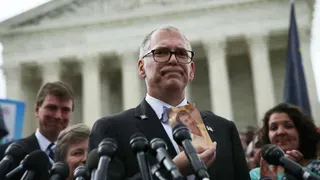March 23, 2013
NYC Museums Exhibit Gay Life Pre-Stonewall & Coping With AIDS
Winnie McCroy READ TIME: 5 MIN.
Two new art exhibits are set to open in New York City, the first looking into gay life before the dawn of the gay liberation movement and the sexual revolution that accompanied it. The second, opening in June, is a sobering look at the early history of the AIDS epidemic. Together, they paint a picture of the highs and lows our community has weathered throughout the last 50 years.
"In the pre-Stonewall era, gay men's lives revolved around decisions to put on and take off masks, when to guard or reveal their desires and selves," said Brenda Marston, curator of "Hooray for Gay: Pre-Stonewall Images from the Collection of Harry Weintraub" and the Cornell University Library's Human Sexuality Collection. "In going through this vast array of photographs, images of men with their faces concealed stood out. When you go through the exhibit, look for the faces: Many are looking away or masked, some are looking right at us. A complex and rich gay culture was hidden in plain sight."
The exhibit, which will open on March 30 at the Boo-Hooray Gallery at 265 Canal Street, Sixth Floor, will run through April 8. During that short period of time, visitors can view one-of-a-kind items from the collection, among them romantic photos of male couples from the late 19th and early 20th centuries, erotic images of military men, vintage physique magazines, photos of drag queens and clippings on gay "criminality," including notices of runaway boys and mug shots for "gay crimes."
The materials were collected by New York City labor lawyer Weintrab over three decades, and are now part of Cornell's permanent collection.
A Sobering Look at NYC’s First AIDS Years
In 1981, rumors of a "gay plague" had men in New York City in a panic. The ensuing years found gay men getting sick and dying quickly, with little response from the government or private health agencies. What resulted was a groundswell of intense activism, political struggle and a start to the clinical research around HIV that would eventually lead to the protease "cocktail" --�and a people's revolution in the way the Food and Drug Administration approves drugs for life-threatenng illnesses.
On June 7, the New York Historical Society will present "AIDS in New York: The First Five Years," a major new exhibition running through Sept. 15.
"For those who lost partners, children, siblings, parents and friends, the memory of the fear and mystery that pervaded New York at the beginning of the AIDS epidemic remains vivid," said curator Jean S. Ashton. "For many people today, though, these years are now a little-understood and nearly forgotten historical period. Yet the trajectory of HIV/AIDS changed paradigms in medicine, society, politics, and culture in ways that are still being felt, and the disease remains with us, affecting some 100,000 New Yorkers and more than one million Americans today. This exhibition explores a history that we continue to live."
The wealth of materials shown include countless photos, posters, pamphlets, newspapers, clinicians' notes, journal entries, letters, audio and video clips, and a copy of the famous Mortality and Morbidity Weekly Report from the Centers for Disease Control that first mentioned HIV. The exhibit will begin by recalling life in New York City before the AIDS crisis, when the city's gay men were at the forefront of the Sexual Revolution.
AIDS quickly put an end to the good times. Bathhouses closed, men were fearful of having sex. Gay men and lesbians (and a few stalwart straight allies) took to the streets and the corridors of power to try to raise funds and influence research priorities. In many cases, they were simply trying to have sick or dying friends treated with dignity by hospitals and funeral homes - or, in many cases, treated at all.
The exhibit does not shy away from looking at the many barriers and outright panic that kept gay men from treating people with AIDS, or even embalming their bodies. Via contemporary news broadcasts and interviews, the Historical Society brings this anger to life.
AIDS Enters the Mainstream
The third section of the exhibit explores progress of HIV research, the discovery of the HIV retrovirus and the first commercial test kit. The founding of ACT-Up in 1986 resulted in an explosion of AIDS activism, as well its effect on the arts, notably Larry Kramer's play "The Normal Heart."
Thanks to a few dedicated gay leaders and high society supporters like Liz Taylor, Mathilda Krim and Judy Peabody, the "second phase" of the epidemic saw the rise of service and research organizations like amfAR and GMHC. Not insignificantly, AIDS went from a pariah word among the moneyed classes to a favored cause.
Following the exhibit in October, a related exhibit, "Why We Fight: AIDS Activism and American Culture," shows these trends within the larger context of cultural shifts and mores. A companion photography exhibit, "Children With AIDS: 1990-2000," will show photos from Clair Yaffa's collection, "The Changing Face of Children With AIDS." On June 1, the World Science Festival will partner with the New York Historical Society to explore what it will take to end the AIDS pandemic with the hopeful title "AIDS in New York: The Last Five Years."
For those who wish to see what the very, very good times and the very, very, very bad times were like in our recent history, these two shows offer an invaluable study in contrast. If you were there in the '70s and '80s, it will undoubtedly bring up plenty of associations, some pleasant, some not so.
For more information on "Hooray for Gay," visit http://rmc.library.cornell.edu/weintraub For information on "AIDS in New York," visit http://www.nyhistory.org/exhibitions/aids-new-york-first-five-years
Winnie McCroy is the Women on the EDGE Editor, HIV/Health Editor, and Assistant Entertainment Editor for EDGE Media Network, handling all women's news, HIV health stories and theater reviews throughout the U.S. She has contributed to other publications, including The Village Voice, Gay City News, Chelsea Now and The Advocate, and lives in Brooklyn, New York.






